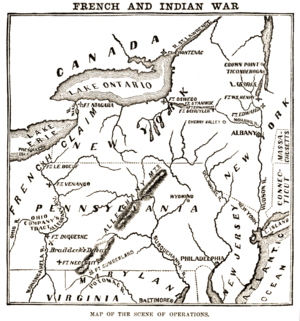Siege of Fort William Henry facts for kids
Quick facts for kids Siege of Fort William Henry |
|||||||
|---|---|---|---|---|---|---|---|
| Part of the French and Indian War | |||||||
 Plan of Fort William Henry and Camp at Lake George |
|||||||
|
|||||||
| Belligerents | |||||||
| Commanders and leaders | |||||||
| Louis-Joseph de Montcalm | George Monro |
||||||
| Strength | |||||||
| 6,200 regulars and militia 1,800 Indians |
2,500 regulars and provincial troops | ||||||
| Casualties and losses | |||||||
| light |
Siege: 130 killed or wounded |
||||||
The siege of Fort William Henry happened from August 3 to August 9, 1757. It was a major event during the French and Indian War. French General Louis-Joseph de Montcalm led his forces against the British-held Fort William Henry.
The fort was located at the southern end of Lake George. This area was a border between the British Province of New York and the French Province of Canada. The British soldiers and local militia inside the fort were led by Lieutenant Colonel George Monro. They did not have much support.
After several days of attacks, Monro surrendered to Montcalm. Montcalm's army included almost 2,000 Indian warriors from different tribes. The surrender terms said the British soldiers could leave safely. They were supposed to be protected by the French army as they marched away.
However, Montcalm's Indian allies did not follow these terms. They attacked the British soldiers as they left the fort. The British had no ammunition for their guns. Many soldiers were killed. Women, children, and servants were taken captive. Sick and wounded prisoners were also killed. Early stories said up to 1,500 people died. But it was likely closer to 200 people, which was less than 10% of the British fighting force.
Historians still debate how much Montcalm and other French leaders were involved. The memory of these killings affected British military leaders for the rest of the war.
Contents
The French and Indian War Begins
The French and Indian War started in 1754. It was fought over land in North America. Both France and Great Britain wanted control of areas in what is now western Pennsylvania and upstate New York. The war began even before Britain and France were officially at war. This happened after George Washington attacked French forces.
The first few years of the war were not good for the British. A large expedition led by General Edward Braddock in 1755 ended badly. British leaders could not plan any major attacks the next year. In August 1756, a French and Indian army led by General Louis-Joseph de Montcalm captured Fort Oswego. This was a big loss for the British. In July 1756, Lord Loudoun took command of the British forces in North America.
British War Plans for 1757
Lord Loudoun planned to attack the main French city of Quebec in 1757. He wanted to keep the border areas safe. This included the important path between Albany, New York and Montreal. This path followed the Hudson River and Lake Champlain.
After a battle in 1755, the French built Fort Carillon. This fort is now called Fort Ticonderoga. It was near the southern end of Lake Champlain. The British built Fort William Henry at the southern end of Lake George. They also built Fort Edward on the Hudson River. Fort Edward was about 16 kilometers (10 miles) south of Fort William Henry. These three forts are all in New York today. The area between Fort William Henry and Fort Carillon was mostly wilderness. It was a "military waterway" that allowed armies to move quickly.
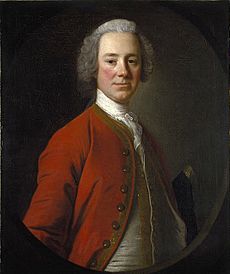
Loudoun's plan depended on his army reaching Quebec quickly. This would stop French troops from attacking other British forts. But there were political problems in London. This led to William Pitt taking control of military matters. Loudoun did not get feedback on his plan until March 1757. Before that, he made plans for the Quebec attack. He also worked with the governors of the Thirteen Colonies to defend the border.
When Pitt's orders arrived, they changed the plan. The British army was now to attack Louisbourg first. This fort was on the Atlantic coast. This change meant French forces in Canada would be free to act elsewhere. Loudoun sent his best troops to Louisbourg. He put Brigadier General Daniel Webb in charge of the New York border. Webb had about 2,000 regular soldiers. The colonies were supposed to send him about 5,000 militia.
French War Plans
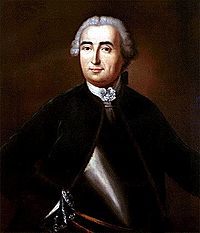
After his success at Fort Oswego in 1756, Montcalm wanted to attack Fort William Henry. It was a good starting point for British attacks on Fort Carillon. At first, Montcalm was careful. He didn't want to attack without knowing more about British forces. But spies in London reported that the British would likely attack Louisbourg. This meant fewer British troops might be on the frontier. This idea was supported by information from captured soldiers.
In December 1756, New France's governor, the Marquis de Vaudreuil, began asking Native Americans to join the campaign. Many warriors joined after hearing stories about the capture of Oswego. By June 1757, nearly 1,000 warriors from distant areas arrived in Montreal. Another 800 Native Americans from closer tribes also joined.
British Fort Preparations
Fort William Henry was built in late 1755. It was a square fort with strong corners. It was designed to stop Native American attacks. But it was not strong enough against enemy artillery. Its walls were 9 meters (30 feet) thick. They had logs on the outside and dirt inside. Inside the fort were two-story wooden barracks. The fort's ammunition storage was in one corner. The hospital was in another.
Three sides of the fort had a dry moat. The fourth side sloped down to the lake. The only way into the fort was over a bridge. The fort could hold only 400 to 500 men. More troops stayed in a camp about 685 meters (750 yards) southeast of the fort. This was near where a battle happened in 1755.
In early 1757, a few hundred men from the 44th Foot guarded Fort William Henry. In March 1757, the French sent 1,500 men to attack the fort. This force had no heavy weapons. They attacked for four days, destroying buildings and boats. Then they left. Lieutenant Colonel George Monro and the 35th Foot replaced the previous troops in the spring. Monro set up his main camp where most of his men were.
French Army Gathers
The Native Americans gathered in Montreal. They were sent south to Fort Carillon. There, they joined French soldiers. With other troops and militia, the French force at Carillon grew to 8,000 men.
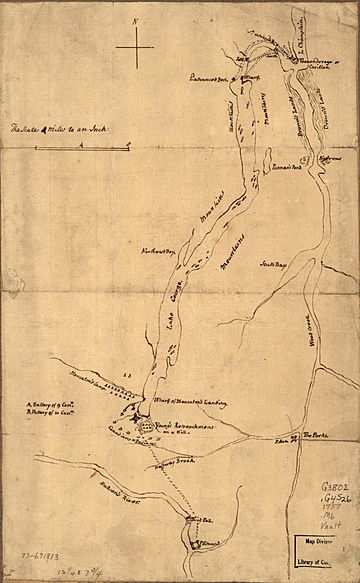
At Carillon, the French leaders found it hard to control their Native American allies. The Native Americans often took more than their share of food. Montcalm's helper, Louis Antoine de Bougainville, noted that stopping this would make them leave. Before the siege, some prisoners were taken in a battle on July 23. Some were killed by Native Americans. Montcalm convinced them to send other captives to Montreal to be sold as slaves.
The Siege Begins
General Webb, who was at Fort Edward, learned in April that the French were gathering forces. More news came in mid-July from a captured soldier. After a French attack near Fort Edward on July 23, Webb went to Fort William Henry. He sent some scouts onto the lake. They reported that Native Americans were camped on islands about 29 kilometers (18 miles) from the fort.
Webb swore the scouts to secrecy and returned to Fort Edward. On August 2, he sent 200 regular soldiers and 800 militia to Fort William Henry. This brought the fort's total strength to about 2,500 men. However, several hundred of them were sick, some with smallpox.
The Attack on the Fort
Montcalm's Native American allies had already moved south. The main French troops left Carillon on July 30. They marched along the western shore of Lake George. Montcalm and the rest of the army sailed the next day. They met up with the advance force. Early on August 3, the French blocked the road between Fort Edward and Fort William Henry. They fought with the recently arrived militia.
Montcalm asked Monro to surrender at 11:00 am. Monro refused. He sent messages to Fort Edward, asking for help. Webb, feeling threatened, refused to send any of his 1,600 men. He believed they were all that stood between the French and Albany. On August 4, Webb wrote to Monro, telling him to get the best surrender terms possible. This message was intercepted and given to Montcalm.
Montcalm ordered his troops to begin the siege. The French dug trenches to the northwest of the fort. They aimed their cannons at the fort's northwest corner. On August 5, French cannons began firing from 1,800 meters (2,000 yards) away. The Native American allies enjoyed watching this. The next day, more cannons fired from closer, creating a crossfire. The British fired back, but their guns were damaged or broke.
On August 7, Montcalm sent a messenger to the fort. He delivered the intercepted message from Webb. By then, the fort's walls were broken. Many of its guns were useless, and many soldiers were hurt. After another day of French bombardment, Monro raised a white flag to surrender.
The Aftermath of Surrender
The surrender terms allowed the British soldiers and their helpers to leave. They would be escorted by the French to Fort Edward. They could keep their muskets and one symbolic cannon, but no ammunition. The British also had to release French prisoners within three months.
Montcalm tried to make sure his Native American allies understood the terms. He asked the chiefs to control their men. This was hard because the Native Americans spoke many different languages. The British soldiers then left the fort and went to their camp. Monro stayed in the French camp. The Native Americans entered the fort and took things. They killed some wounded and sick British soldiers left behind. French guards tried to keep the Native Americans out of the British camp, but it was difficult.
Montcalm and Monro first planned to march the prisoners south that night. But after seeing the Native Americans' anger, they decided to wait until morning. When the Native Americans realized the British were preparing to leave, many gathered around the camp. This made the leaders cancel the march for the night.
The Attack on the Column
The next morning, before the British even started marching, the Native Americans attacked again. At 5 a.m., Native Americans entered huts where wounded British soldiers were. These soldiers were supposed to be cared for by French doctors. The Native Americans killed and scalped them. Monro complained that the surrender terms were broken. But his group had to give up some of their belongings just to start the march.
As they marched, the Native Americans bothered them. They grabbed weapons and clothes. They pulled away anyone who fought back, including many women, children, and servants. As the last men left the camp, a war cry sounded. A group of Abenaki warriors seized several men at the back of the column.
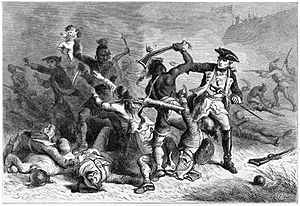
Montcalm and other French officers tried to stop the attacks. But some officers did not help, and some refused to protect the British. At this point, the British column broke apart. Some tried to run away, while others tried to defend themselves. One British officer, Colonel Joseph Frye, reported that he was stripped of his clothes and threatened. He ran into the woods and reached Fort Edward days later.
The number of people killed, wounded, or captured varies in different reports. Historians estimate that between 69 and 184 British soldiers were killed or went missing. This was at most 7.5% of the 2,308 who surrendered.
After the Siege
Most of the Native Americans left the day after the attack. They went back to their homes. Montcalm managed to get 500 captives released. But another 200 were taken away. The French stayed at the fort for several days. They destroyed what was left of the British defenses. Then they left on August 18 and returned to Fort Carillon.
For reasons still unclear, Montcalm did not attack Fort Edward after his victory. Many reasons have been suggested. These include many Native Americans leaving, a lack of supplies, and the need for Canadian militia to return home for harvest.
News of the French movements reached the British Indian agent William Johnson on August 1. Unlike Webb, Johnson acted quickly. He arrived at Fort Edward on August 6 with 1,500 militia and 150 Native Americans. Webb refused to let Johnson advance toward Fort William Henry. Webb seemed to believe a French report that their army was 11,000 strong. He thought any rescue attempt would fail.
Captives Return Home
On August 14, Montcalm wrote letters to Loudoun and Webb. He apologized for the Native Americans' actions but also tried to explain them. Many captives taken to Montreal were eventually returned. This happened through prisoner exchanges arranged by Governor Vaudreuil. On September 27, a small British fleet left Quebec. It carried prisoners who had been released or exchanged. These included people captured at Fort William Henry and Oswego. When the fleet reached Halifax, about 300 people from Fort William Henry were returned. The fleet continued to Europe, where a few more captives were released. Some of them also eventually returned to the colonies.
Impact of the Siege
General Webb was removed from his command because of his actions. William Johnson wrote that Webb was "the only Englishman [I] ever knew who was a coward." Lord Loudoun was also recalled. This was mainly because his Louisbourg expedition failed. Colonel Monro died in November 1757. Some historians think his death was caused by anger over Webb's lack of support.
Lord Loudoun was upset about the event. He delayed releasing French prisoners, even though it was part of the surrender terms. General James Abercrombie took over as commander. Soldiers from the 35th Foot asked him to cancel their agreement not to fight for 18 months. Abercrombie agreed. These soldiers then fought under Jeffery Amherst in 1758. Amherst successfully captured Louisbourg. When Montreal surrendered in 1760, Amherst refused to give the French soldiers the usual honors of war. This was partly because the French had not kept their promises at Fort William Henry.
Fort William Henry Today
The British never rebuilt anything on the site of Fort William Henry. It remained in ruins for about 200 years. In the 1950s, archaeologists dug up the site. This led to the reconstruction of Fort William Henry. Today, it is a tourist attraction in the town of Lake George.
Many old stories focused on the Native Americans taking things and killing those who resisted. They used words like "massacre," even though the number of deaths was not clear. Later, when captives were released, it did not get as much attention. The events of the battle were shown in the 1826 novel The Last of the Mohicans by James Fenimore Cooper. They were also in movies based on the book. Cooper's story has many mistakes. But his work, and other early historical accounts, made people believe many more died than actually did. Many more were captured than killed, and many of those captured were eventually set free.

Historians disagree about who was responsible for the Native American actions. Some say Montcalm knew what would happen and ignored it. They say he only stepped in after the attacks began. Others strongly defend Montcalm. They claim he and other French officers did all they could to stop the attacks but could not.
One historian, Ian Steele, notes that two main accounts shaped history. The first is Montcalm's record, including the surrender terms and his letters. These were widely published. The second is a book from 1778 by Jonathan Carver. He was a soldier present at the siege. Carver claimed, without proof, that 1,500 people were "killed or made prisoner." This idea became very popular. A Yale College president later used the phrase "massacre at Fort William Henry." His book and Carver's likely influenced Cooper. They tended to blame Montcalm for the Native American actions.
Steele offers a more balanced view. Montcalm and the French leaders promised the Native Americans glory and war trophies. These included taking things, scalping, and capturing people. After an earlier battle, captives were ransomed, meaning the Native Americans got no visible trophies. The surrender terms at Fort William Henry also gave the Native Americans nothing. The French army claimed the war supplies, and the British kept their personal items. This made the Native Americans angry. They felt the French were working with their enemies (the British) against their friends (the Native Americans). This left them without the promised war trophies.
Native American Nations Present
Many Native American nations were present during the siege. Some were represented by only a few warriors. Some individuals traveled very long distances, even from the Mississippi River and Hudson Bay. Historian William Nester suggests that some of the attacks, like killing sick people and digging up bodies, led to many Native Americans getting smallpox. They then carried the disease back to their communities. The disease caused great harm in the following years. This affected how many Native Americans joined French campaigns later on.
The tribes Nester lists are:
See also
 In Spanish: Batalla de Fort William Henry para niños
In Spanish: Batalla de Fort William Henry para niños


